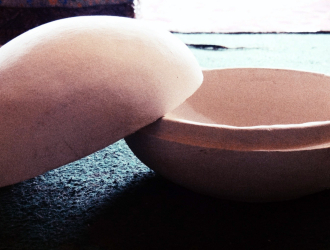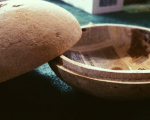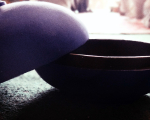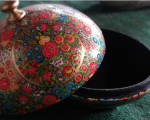Papier mache making is roughly divided between two sets of artists—sakhtasaz and naqqash. The sakhtasazi artists are involved with processing the base material and preparing the skeleton framework of the craft while the naqqashi artists deal with designing and polishing. The two sets of artists work in separate karkhanas (workspaces).
In the Hands of the Sakhtasaz
Papier mache requires processed paper as base material. Press cuttings, pages from used school notebooks and tissue papers are kept in water for a period of five to six days, stretching to 15 in the winters.
After they have been adequately soaked, large chunks of the paper are placed in a stone mortar and ground with a wooden pestle. A variety of rice flour called maand is then added to the ground paper and the mixture is poured into frameworks of different shapes and sizes. Once it settles into the cast and dries up, it acquires the desired shape. The skeleton framework needs four to five days to harden. In the winters when it takes longer, bukharis (traditional heaters) are installed in the karkhanas to speed up the process. The dried structures are cut out with a saw and a rough coat of paint is added to smoothen the surface.
From the Brush of the Naqqash
Once the base is fit for use, the object is shifted to another karkhana where the naqqashi artists take over. It is coated with a mixture of chalk mitti (powder) and saresh (a type of adhesive), and polished with a kiln-burnt brick. This process is called gassayiee. Once the piece acquires the desired texture, a layer of tissues is glued to it to make it water-resistant and prevent it from developing cracks. It receives several rounds of gassayiee with sandpaper followed by three or four thick coats of colour. As the paint dries up, various designs are drawn on the papier mache item followed by a layer of varnish to lock the hues. Finally, after a round of finishing with mohra (a type of stone), the item is ready for display.
Motifs
Papier mache uses a wide range of motifs. Most of the motifs—like gul-andar-gul, gul-i-hazara, bagaldar, chinar, gonder, gul-i-wilayat and kashaan—retain their original Persian names. Many papier mache artworks carry the designs that also appear in other forms of Kashmiri handicrafts like shawls, carpets and woodwork, earning themselves names like kaleen (carpet), jamavar (a type of shawl worn by Kashmiris) and pashmina. Contemporary papier mache art includes Mughal designs inspired by paintings and folktales from the period of their rule and ‘Indian designs’, which are illustrations of Indian villages.

















